Graphics in Python¶
The foundational package for most graphics in Python is
`matplotlib <http://matplotlib.org>`__, and the
`seaborn <http://stanford.edu/~mwaskom/software/seaborn/>`__ package
builds on this to provide more statistical graphing options. We will
focus on these two packages, but there are many others if these don’t
meet your needs.
There are also several specialized packages that might come in useful:
`ggplot<http://ggplot.yhathq.com>`__ is a port of the Rggplto2library to Python`vispy<http://vispy.org>`__ and`lightning<http://lightning-viz.org>`__ for interactive visualization of large data sets`bokeh<http://bokeh.pydata.org/en/latest/>`__ for web-friendly interactive graphics`pyxley<pyxley%20github>`__ and`spyre<spyre%20pyton>`__ for Rshinyfans and several others.
Resources¶
import warnings
warnings.filterwarnings("ignore")
Matplotlib¶
Matplotlib has a “functional” interface similar to Matlab via the
pyplot module for simple interactive use, as well as an
object-oriented interface that is useful for more complex graphic
creations.
Types of plots¶
plt.hist(np.random.randn(1000), bins=np.linspace(-4,4,11))
pass
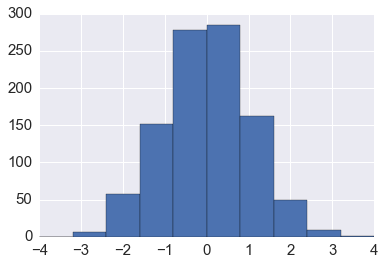
plt.boxplot(np.random.random((6,10)))
pass
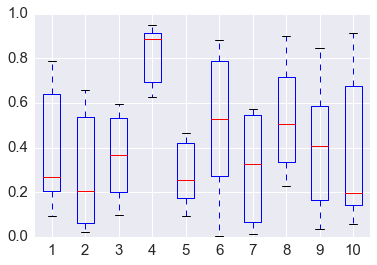
plt.scatter(*np.random.uniform(0.1, 0.9, (2,100)),
s=np.random.randint(10, 200, 100),
c=np.random.random(100))
pass

plt.stem(np.random.random(8))
plt.margins(0.05)
pass

x = np.linspace(0, 2*np.pi, 100)
y = np.sin(x)
plt.plot(x, y)
plt.axis([0, 2*np.pi, -1.05, 1.05,])
pass

Colors¶
plt.scatter(*np.random.uniform(0.1, 0.9, (2,100)),
s=np.random.randint(10, 200, 100),
c=np.random.random(100))
pass
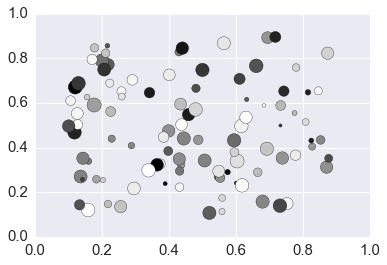
plt.scatter(*np.random.uniform(0.1, 0.9, (2,100)),
s=np.random.randint(10, 200, 100),
c=np.random.random(100), cmap='summer')
pass

plt.scatter(*np.random.uniform(0.1, 0.9, (2,100)),
s=np.random.randint(10, 200, 100),
c=np.random.random(100), cmap='hsv')
pass

Gettting a list of colors from a colormap¶
Giving an argument of 0.0 < x < 1.0 to a colormap gives the
appropriate interpolated color.
# find the bottom, middle and top colors of the winter colormap
colors = plt.cm.winter(np.linspace(0, 1, 3))
colors
array([[ 0. , 0. , 1. , 1. ],
[ 0. , 0.50196078, 0.74901961, 1. ],
[ 0. , 1. , 0.5 , 1. ]])
plt.scatter(*np.random.uniform(0.1, 0.9, (2,100)),
s=np.random.randint(10, 200, 100),
c=colors)
pass

Styles¶
plt.style.available
['seaborn-ticks',
'seaborn-white',
'seaborn-whitegrid',
'seaborn-colorblind',
'seaborn-pastel',
'seaborn-poster',
'seaborn-paper',
'ggplot',
'seaborn-deep',
'bmh',
'seaborn-talk',
'seaborn-dark',
'dark_background',
'seaborn-bright',
'fivethirtyeight',
'seaborn-notebook',
'classic',
'presentation',
'seaborn-muted',
'seaborn-dark-palette',
'grayscale',
'seaborn-darkgrid']
with plt.style.context('classic'):
plt.plot(x, y)
plt.axis([0, 2*np.pi, -1.05, 1.05,])
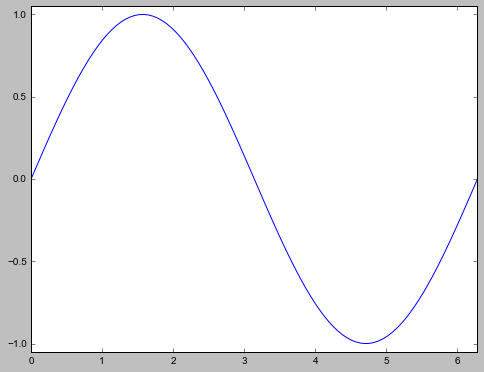
with plt.style.context('fivethirtyeight'):
plt.plot(x, y)
plt.axis([0, 2*np.pi, -1.05, 1.05,])

with plt.style.context('ggplot'):
plt.plot(x, y)
plt.axis([0, 2*np.pi, -1.05, 1.05,])

with plt.xkcd():
plt.plot(x, y)
plt.axis([0, 2*np.pi, -1.05, 1.05,])

Creating your onw style¶
Many, many options can be configured.
plt.rcParams
RcParams({'agg.path.chunksize': 0,
'animation.avconv_args': [],
'animation.avconv_path': 'avconv',
'animation.bitrate': -1,
'animation.codec': 'mpeg4',
'animation.convert_args': [],
'animation.convert_path': 'convert',
'animation.ffmpeg_args': [],
'animation.ffmpeg_path': 'ffmpeg',
'animation.frame_format': 'png',
'animation.html': 'none',
'animation.mencoder_args': [],
'animation.mencoder_path': 'mencoder',
'animation.writer': 'ffmpeg',
'axes.axisbelow': True,
'axes.edgecolor': 'white',
'axes.facecolor': '#EAEAF2',
'axes.formatter.limits': [-7, 7],
'axes.formatter.use_locale': False,
'axes.formatter.use_mathtext': False,
'axes.formatter.useoffset': True,
'axes.grid': True,
'axes.grid.axis': 'both',
'axes.grid.which': 'major',
'axes.hold': True,
'axes.labelcolor': '.15',
'axes.labelpad': 5.0,
'axes.labelsize': 16.5,
'axes.labelweight': 'normal',
'axes.linewidth': 0.0,
'axes.prop_cycle': cycler('color', [(0.2980392156862745, 0.4470588235294118, 0.6901960784313725), (0.3333333333333333, 0.6588235294117647, 0.40784313725490196), (0.7686274509803922, 0.3058823529411765, 0.3215686274509804), (0.5058823529411764, 0.4470588235294118, 0.6980392156862745), (0.8, 0.7254901960784313, 0.4549019607843137), (0.39215686274509803, 0.7098039215686275, 0.803921568627451)]),
'axes.spines.bottom': True,
'axes.spines.left': True,
'axes.spines.right': True,
'axes.spines.top': True,
'axes.titlesize': 18.0,
'axes.titleweight': 'normal',
'axes.unicode_minus': True,
'axes.xmargin': 0.0,
'axes.ymargin': 0.0,
'axes3d.grid': True,
'backend': 'module://ipykernel.pylab.backend_inline',
'backend.qt4': 'PyQt4',
'backend.qt5': 'PyQt5',
'backend_fallback': True,
'boxplot.bootstrap': None,
'boxplot.boxprops.color': 'b',
'boxplot.boxprops.linestyle': '-',
'boxplot.boxprops.linewidth': 1.0,
'boxplot.capprops.color': 'k',
'boxplot.capprops.linestyle': '-',
'boxplot.capprops.linewidth': 1.0,
'boxplot.flierprops.color': 'b',
'boxplot.flierprops.linestyle': 'none',
'boxplot.flierprops.linewidth': 1.0,
'boxplot.flierprops.marker': '+',
'boxplot.flierprops.markeredgecolor': 'k',
'boxplot.flierprops.markerfacecolor': 'b',
'boxplot.flierprops.markersize': 6.0,
'boxplot.meanline': False,
'boxplot.meanprops.color': 'r',
'boxplot.meanprops.linestyle': '-',
'boxplot.meanprops.linewidth': 1.0,
'boxplot.medianprops.color': 'r',
'boxplot.medianprops.linestyle': '-',
'boxplot.medianprops.linewidth': 1.0,
'boxplot.notch': False,
'boxplot.patchartist': False,
'boxplot.showbox': True,
'boxplot.showcaps': True,
'boxplot.showfliers': True,
'boxplot.showmeans': False,
'boxplot.vertical': True,
'boxplot.whiskerprops.color': 'b',
'boxplot.whiskerprops.linestyle': '--',
'boxplot.whiskerprops.linewidth': 1.0,
'boxplot.whiskers': 1.5,
'contour.corner_mask': True,
'contour.negative_linestyle': 'dashed',
'datapath': '/Users/cliburn/anaconda/envs/py35/lib/python3.5/site-packages/matplotlib/mpl-data',
'docstring.hardcopy': False,
'errorbar.capsize': 3.0,
'examples.directory': '',
'figure.autolayout': False,
'figure.dpi': 80.0,
'figure.edgecolor': (1, 1, 1, 0),
'figure.facecolor': (1, 1, 1, 0),
'figure.figsize': [6.0, 4.0],
'figure.frameon': True,
'figure.max_open_warning': 20,
'figure.subplot.bottom': 0.125,
'figure.subplot.hspace': 0.2,
'figure.subplot.left': 0.125,
'figure.subplot.right': 0.9,
'figure.subplot.top': 0.9,
'figure.subplot.wspace': 0.2,
'figure.titlesize': 'medium',
'figure.titleweight': 'normal',
'font.cursive': ['Apple Chancery',
'Textile',
'Zapf Chancery',
'Sand',
'Script MT',
'Felipa',
'cursive'],
'font.family': ['sans-serif'],
'font.fantasy': ['Comic Sans MS',
'Chicago',
'Charcoal',
'ImpactWestern',
'Humor Sans',
'fantasy'],
'font.monospace': ['Bitstream Vera Sans Mono',
'DejaVu Sans Mono',
'Andale Mono',
'Nimbus Mono L',
'Courier New',
'Courier',
'Fixed',
'Terminal',
'monospace'],
'font.sans-serif': ['Arial',
'Liberation Sans',
'Bitstream Vera Sans',
'sans-serif'],
'font.serif': ['Bitstream Vera Serif',
'DejaVu Serif',
'New Century Schoolbook',
'Century Schoolbook L',
'Utopia',
'ITC Bookman',
'Bookman',
'Nimbus Roman No9 L',
'Times New Roman',
'Times',
'Palatino',
'Charter',
'serif'],
'font.size': 10.0,
'font.stretch': 'normal',
'font.style': 'normal',
'font.variant': 'normal',
'font.weight': 'normal',
'grid.alpha': 1.0,
'grid.color': 'white',
'grid.linestyle': '-',
'grid.linewidth': 1.0,
'image.aspect': 'equal',
'image.cmap': 'Greys',
'image.composite_image': True,
'image.interpolation': 'bilinear',
'image.lut': 256,
'image.origin': 'upper',
'image.resample': False,
'interactive': True,
'keymap.all_axes': ['a'],
'keymap.back': ['left', 'c', 'backspace'],
'keymap.forward': ['right', 'v'],
'keymap.fullscreen': ['f', 'ctrl+f'],
'keymap.grid': ['g'],
'keymap.home': ['h', 'r', 'home'],
'keymap.pan': ['p'],
'keymap.quit': ['ctrl+w', 'cmd+w'],
'keymap.save': ['s', 'ctrl+s'],
'keymap.xscale': ['k', 'L'],
'keymap.yscale': ['l'],
'keymap.zoom': ['o'],
'legend.borderaxespad': 0.5,
'legend.borderpad': 0.4,
'legend.columnspacing': 2.0,
'legend.edgecolor': 'inherit',
'legend.facecolor': 'inherit',
'legend.fancybox': False,
'legend.fontsize': 15.0,
'legend.framealpha': None,
'legend.frameon': False,
'legend.handleheight': 0.7,
'legend.handlelength': 2.0,
'legend.handletextpad': 0.8,
'legend.isaxes': True,
'legend.labelspacing': 0.5,
'legend.loc': 'upper right',
'legend.markerscale': 1.0,
'legend.numpoints': 1,
'legend.scatterpoints': 1,
'legend.shadow': False,
'lines.antialiased': True,
'lines.color': 'b',
'lines.dash_capstyle': 'butt',
'lines.dash_joinstyle': 'round',
'lines.linestyle': '-',
'lines.linewidth': 1.75,
'lines.marker': 'None',
'lines.markeredgewidth': 0.0,
'lines.markersize': 7.0,
'lines.solid_capstyle': 'round',
'lines.solid_joinstyle': 'round',
'markers.fillstyle': 'full',
'mathtext.bf': 'serif:bold',
'mathtext.cal': 'cursive',
'mathtext.default': 'it',
'mathtext.fallback_to_cm': True,
'mathtext.fontset': 'cm',
'mathtext.it': 'serif:italic',
'mathtext.rm': 'serif',
'mathtext.sf': 'sans\-serif',
'mathtext.tt': 'monospace',
'nbagg.transparent': True,
'patch.antialiased': True,
'patch.edgecolor': 'k',
'patch.facecolor': (0.2980392156862745,
0.4470588235294118,
0.6901960784313725),
'patch.linewidth': 0.3,
'path.effects': [],
'path.simplify': True,
'path.simplify_threshold': 0.1111111111111111,
'path.sketch': None,
'path.snap': True,
'pdf.compression': 6,
'pdf.fonttype': 3,
'pdf.inheritcolor': False,
'pdf.use14corefonts': False,
'pgf.debug': False,
'pgf.preamble': [],
'pgf.rcfonts': True,
'pgf.texsystem': 'xelatex',
'plugins.directory': '.matplotlib_plugins',
'polaraxes.grid': True,
'ps.distiller.res': 6000,
'ps.fonttype': 3,
'ps.papersize': 'letter',
'ps.useafm': False,
'ps.usedistiller': False,
'savefig.bbox': None,
'savefig.directory': '~',
'savefig.dpi': 72.0,
'savefig.edgecolor': 'w',
'savefig.facecolor': 'w',
'savefig.format': 'png',
'savefig.frameon': True,
'savefig.jpeg_quality': 95,
'savefig.orientation': 'portrait',
'savefig.pad_inches': 0.1,
'savefig.transparent': False,
'svg.fonttype': 'path',
'svg.image_inline': True,
'svg.image_noscale': False,
'text.antialiased': True,
'text.color': '.15',
'text.dvipnghack': None,
'text.hinting': 'auto',
'text.hinting_factor': 8,
'text.latex.preamble': [],
'text.latex.preview': False,
'text.latex.unicode': False,
'text.usetex': False,
'timezone': 'UTC',
'tk.window_focus': False,
'toolbar': 'toolbar2',
'verbose.fileo': 'sys.stdout',
'verbose.level': 'silent',
'webagg.open_in_browser': True,
'webagg.port': 8988,
'webagg.port_retries': 50,
'xtick.color': '.15',
'xtick.direction': 'out',
'xtick.labelsize': 15.0,
'xtick.major.pad': 7.0,
'xtick.major.size': 0.0,
'xtick.major.width': 1.0,
'xtick.minor.pad': 4.0,
'xtick.minor.size': 0.0,
'xtick.minor.visible': False,
'xtick.minor.width': 0.5,
'ytick.color': '.15',
'ytick.direction': 'out',
'ytick.labelsize': 15.0,
'ytick.major.pad': 7.0,
'ytick.major.size': 0.0,
'ytick.major.width': 1.0,
'ytick.minor.pad': 4.0,
'ytick.minor.size': 0.0,
'ytick.minor.visible': False,
'ytick.minor.width': 0.5})
%%file foo.mplstyle
axes.grid: True
axes.titlesize : 24
axes.labelsize : 20
lines.linewidth : 3
lines.markersize : 10
xtick.labelsize : 16
ytick.labelsize : 16
Overwriting foo.mplstyle
with plt.style.context('foo.mplstyle'):
plt.plot(x, y)
plt.axis([0, 2*np.pi, -1.05, 1.05,])
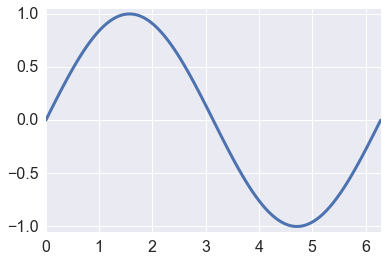
Customizing plots¶
plt.rcParams.update({'font.size': 22})
fig = plt.figure(figsize=(8,6))
ax = plt.subplot(1,1,1)
plt.plot(x, y, color='red', linewidth=2, linestyle='dashed', label='sine curve')
plt.plot(x, np.cos(x), 'b-', label='cosine curve')
plt.legend(loc='best', fontsize=14)
plt.axis([0, 2*np.pi, -1.05, 1.05,])
plt.xlabel('x')
plt.ylabel('sin(x)')
plt.xticks([0,0.5*np.pi,np.pi,1.5*np.pi,2*np.pi],
[0, r'$\frac{\pi}{2}$', r'$\pi$', r'$\frac{3\pi}{2}$', r'$2\pi$'])
plt.title('Sine and Cosine Plots')
plt.text(0.45, 0.9, 'Empty space', transform=ax.transAxes, ha='left', va='top')
pass
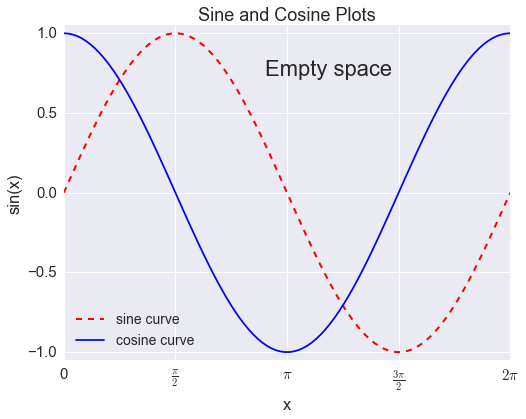
Plot layouts¶
fig, axes = plt.subplots(2,2,figsize=(8,8))
axes[0,0].plot(x,y, 'r')
axes[0,1].plot(x,y, 'g')
axes[1,0].plot(x,y, 'b')
axes[1,1].plot(x,y, 'k')
for ax in axes.ravel():
ax.margins(0.05)
pass

ax1 = plt.subplot2grid((3,3), (0,0), colspan=3)
ax2 = plt.subplot2grid((3,3), (1,0), colspan=2)
ax3 = plt.subplot2grid((3,3), (1,2), rowspan=2)
ax4 = plt.subplot2grid((3,3), (2,0), colspan=2)
axes = [ax1, ax2, ax3, ax4]
colors = ['r', 'g', 'b', 'k']
for ax, c in zip(axes, colors):
ax.plot(x, y, c)
ax.margins(0.05)
plt.tight_layout()
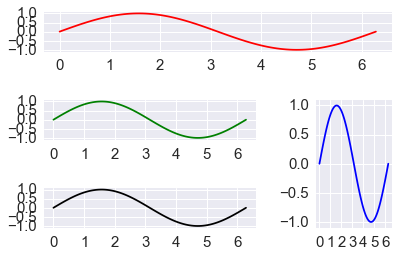
Seaborn¶
sns.set_context("notebook", font_scale=1.5, rc={"lines.linewidth": 2.5})
import numpy.random as rng
Density plots¶
xs = rng.normal(0,1,100)
fig, axes = plt.subplots(1, 2, figsize=(8,4))
sns.distplot(xs, hist=False, rug=True, ax=axes[0]);
sns.distplot(xs, hist=True, ax=axes[1])
pass
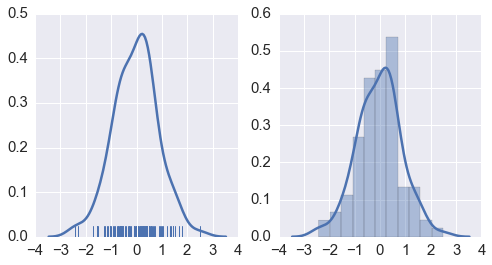
Kernel density estimate¶
sns.kdeplot(np.r_[rng.normal(0,1,50), rng.normal(4,0.8,100)])
pass

iris = sns.load_dataset('iris')
iris.head()
| sepal_length | sepal_width | petal_length | petal_width | species | |
|---|---|---|---|---|---|
| 0 | 5.1 | 3.5 | 1.4 | 0.2 | setosa |
| 1 | 4.9 | 3.0 | 1.4 | 0.2 | setosa |
| 2 | 4.7 | 3.2 | 1.3 | 0.2 | setosa |
| 3 | 4.6 | 3.1 | 1.5 | 0.2 | setosa |
| 4 | 5.0 | 3.6 | 1.4 | 0.2 | setosa |
Joint distribution plot¶
sns.jointplot(x='petal_length', y='petal_width', data=iris, kind='kdeplot')
pass
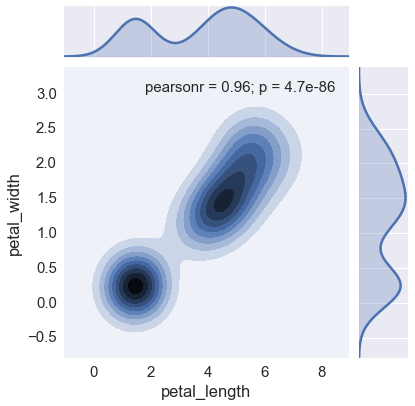
Box and violin plots¶
fig, axes = plt.subplots(1, 2, figsize=(8,4))
sns.boxplot(x='species', y='petal_length', data=iris, ax=axes[0])
sns.violinplot(x='species', y='petal_length', data=iris, ax=axes[1])
pass

Composite plots¶
url = 'https://raw.githubusercontent.com/mwaskom/seaborn-data/master/titanic.csv'
titanic = pd.read_csv(url)
titanic.head()
| survived | pclass | sex | age | sibsp | parch | fare | embarked | class | who | adult_male | deck | embark_town | alive | alone | |
|---|---|---|---|---|---|---|---|---|---|---|---|---|---|---|---|
| 0 | 0 | 3 | male | 22 | 1 | 0 | 7.2500 | S | Third | man | True | NaN | Southampton | no | False |
| 1 | 1 | 1 | female | 38 | 1 | 0 | 71.2833 | C | First | woman | False | C | Cherbourg | yes | False |
| 2 | 1 | 3 | female | 26 | 0 | 0 | 7.9250 | S | Third | woman | False | NaN | Southampton | yes | True |
| 3 | 1 | 1 | female | 35 | 1 | 0 | 53.1000 | S | First | woman | False | C | Southampton | yes | False |
| 4 | 0 | 3 | male | 35 | 0 | 0 | 8.0500 | S | Third | man | True | NaN | Southampton | no | True |
sns.set_context('notebook', font_scale=1.5)
sns.lmplot(x='fare', y='survived', col='alone', row='sex', data=titanic, logistic=True)
pass
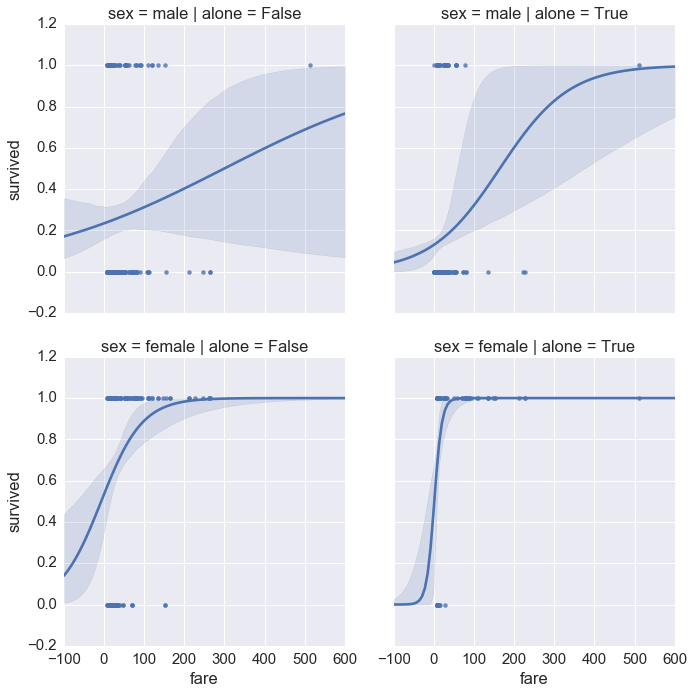
g = sns.PairGrid(titanic,
y_vars=['fare', 'age'],
x_vars=['sex', 'class', 'embark_town' ],
aspect=1, size=5.5)
g.map(sns.stripplot, jitter=True, palette="bright")
pass

Using ggplot as an alternative to seaborn.¶
The ggplot module is a port of R’s ggplot2 - usage is very
similar except for the following minor differences:
- Pass in a
pandasdataframe - aethetics comes before data in the argument list ot ggplot
- Give column names and other arugments (e.g.. function to call) as strings
- You need to use the line continuation character
\to extend over multiple lines
Only the most elementary examples are shown below. The ggplot module
is extremely rich and sophisticated with a steep learning curve if
you’re not already familiar with it from R. Please see
documentation for
details.
from ggplot import *
Interacting with R¶
%load_ext rpy2.ipython
Note that we are exporting the R mtcars dataframe to Python (converts to pandas DataFrame)¶
%R -o mtcars
mtcars.head()
| mpg | cyl | disp | hp | drat | wt | qsec | vs | am | gear | carb | |
|---|---|---|---|---|---|---|---|---|---|---|---|
| Mazda RX4 | 21.0 | 6 | 160 | 110 | 3.90 | 2.620 | 16.46 | 0 | 1 | 4 | 4 |
| Mazda RX4 Wag | 21.0 | 6 | 160 | 110 | 3.90 | 2.875 | 17.02 | 0 | 1 | 4 | 4 |
| Datsun 710 | 22.8 | 4 | 108 | 93 | 3.85 | 2.320 | 18.61 | 1 | 1 | 4 | 1 |
| Hornet 4 Drive | 21.4 | 6 | 258 | 110 | 3.08 | 3.215 | 19.44 | 1 | 0 | 3 | 1 |
| Hornet Sportabout | 18.7 | 8 | 360 | 175 | 3.15 | 3.440 | 17.02 | 0 | 0 | 3 | 2 |
ggplot(aes(x='wt', y='mpg'), data=mtcars,) + geom_point()

<ggplot: (292414163)>
ggplot(aes(x='wt', y='mpg'), data=mtcars) + geom_point() + geom_smooth(method='loess')

<ggplot: (292201757)>
ggplot(aes(x='wt', y='mpg'), data=mtcars) + geom_point() + geom_line()
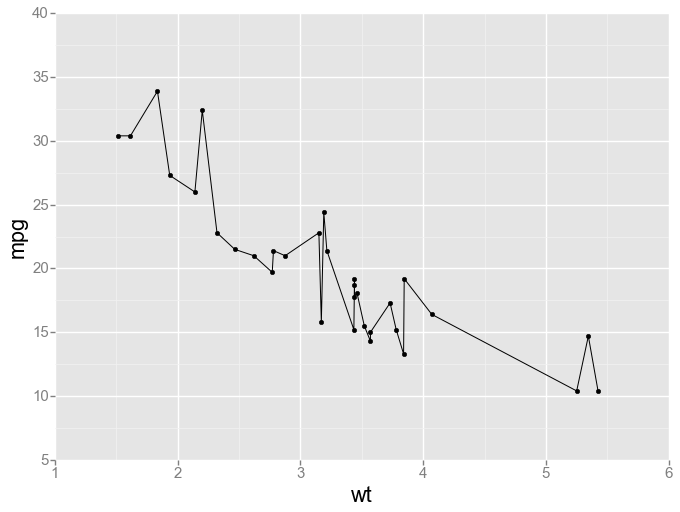
<ggplot: (287265863)>
ggplot(aes(x='mpg'), data=mtcars) + geom_histogram(binwidth=2)
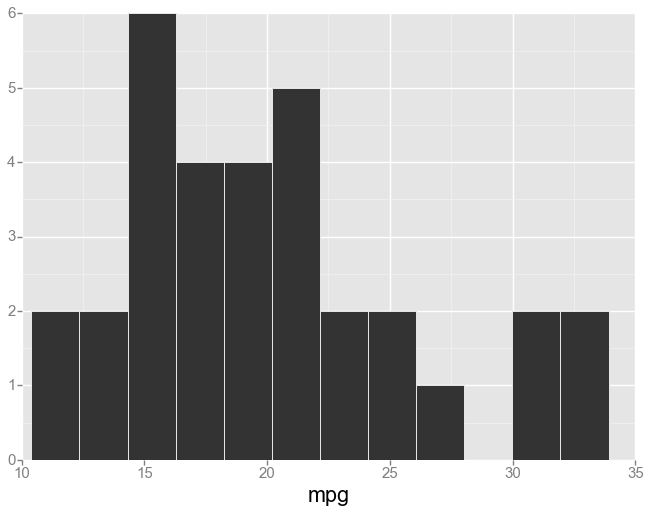
<ggplot: (-9223372036566578744)>
ggplot(aes(x='mpg'), mtcars) + \
geom_line(stat="density") + \
xlim(2.97, 41.33) + \
labs(title="Density plot")
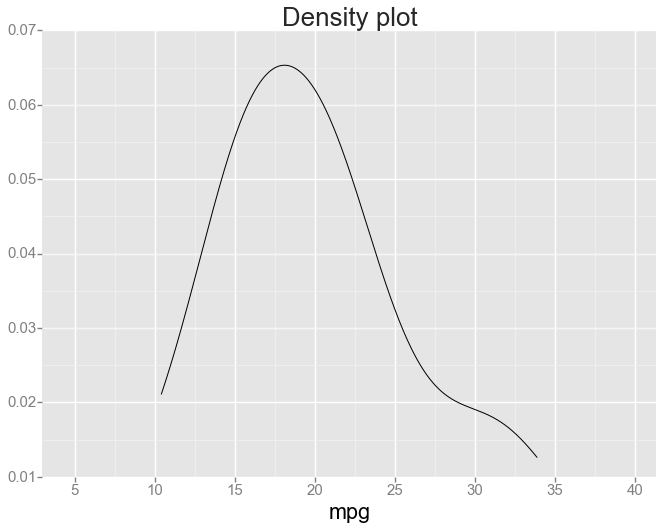
<ggplot: (288465612)>
Use ggplot in R directly with %R magic¶
cars = mtcars
Note that we pass in Python variables with the -i optin and using the %%R cell magic¶
%%R -i cars
library('ggplot2')
ggplot(cars, aes(x=mpg, y=am)) +
geom_point(position=position_jitter(width=.3, height=.08), shape=21, alpha=0.6, size=3) +
stat_smooth(method=glm, method.args=list(family="binomial"), color="red")
